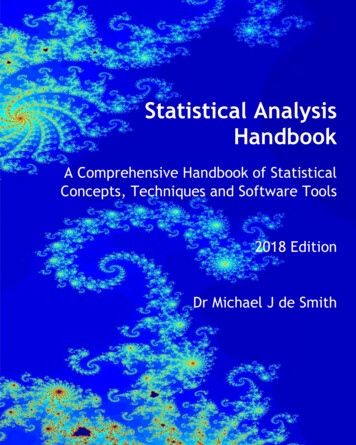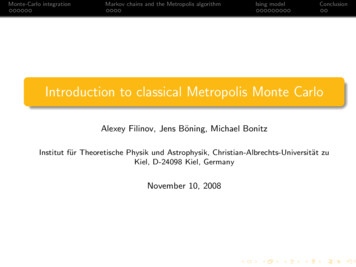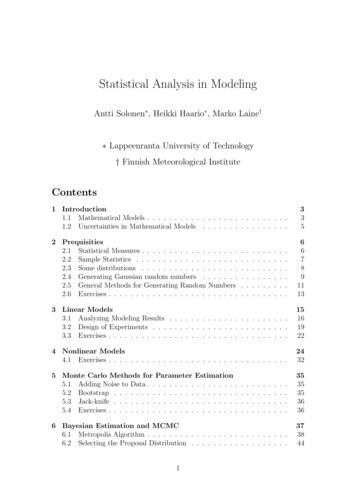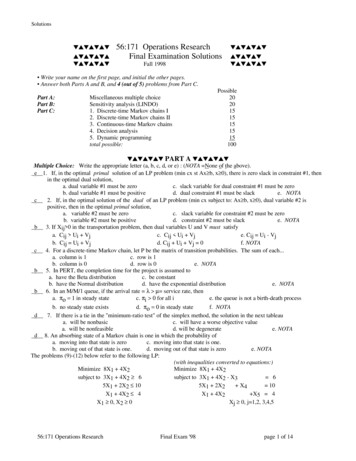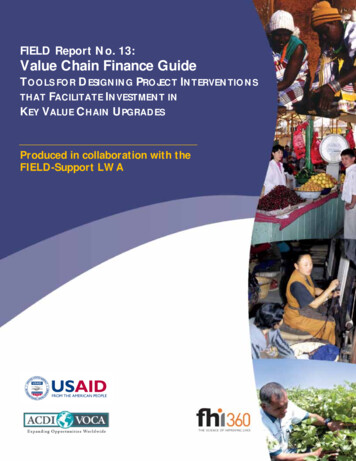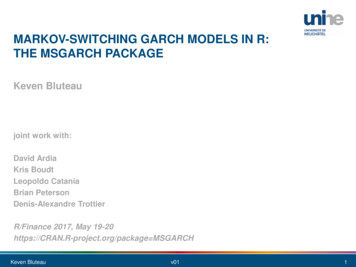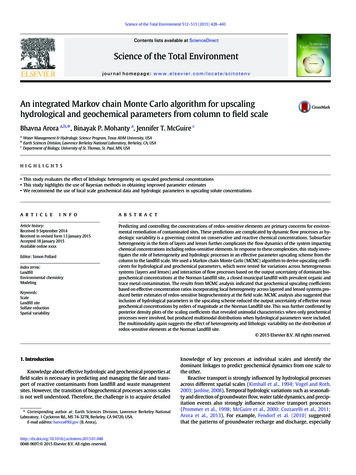
Transcription
Science of the Total Environment 512–513 (2015) 428–443Contents lists available at ScienceDirectScience of the Total Environmentjournal homepage: www.elsevier.com/locate/scitotenvAn integrated Markov chain Monte Carlo algorithm for upscalinghydrological and geochemical parameters from column to field scaleBhavna Arora a,b,⁎, Binayak P. Mohanty a, Jennifer T. McGuire cabcWater Management & Hydrologic Science Program, Texas A&M University, USAEarth Sciences Division, Lawrence Berkeley National Laboratory, Berkeley, CA, USADepartment of Biology, University of St. Thomas, St. Paul, MN, USAH I G H L I G H T S This study evaluates the effect of lithologic heterogeneity on upscaled geochemical concentrations This study highlights the use of Bayesian methods in obtaining improved parameter estimates We recommend the use of local scale geochemical data and hydrologic parameters in upscaling solute concentrationsa r t i c l ei n f oArticle history:Received 9 September 2014Received in revised form 13 January 2015Accepted 18 January 2015Available online xxxxEditor: Simon PollardIndex terms:LandfillEnvironmental chemistryModelingKeywords:ScaleLandfill siteSulfate reductionSpatial variabilitya b s t r a c tPredicting and controlling the concentrations of redox-sensitive elements are primary concerns for environmental remediation of contaminated sites. These predictions are complicated by dynamic flow processes as hydrologic variability is a governing control on conservative and reactive chemical concentrations. Subsurfaceheterogeneity in the form of layers and lenses further complicates the flow dynamics of the system impactingchemical concentrations including redox-sensitive elements. In response to these complexities, this study investigates the role of heterogeneity and hydrologic processes in an effective parameter upscaling scheme from thecolumn to the landfill scale. We used a Markov chain Monte Carlo (MCMC) algorithm to derive upscaling coefficients for hydrological and geochemical parameters, which were tested for variations across heterogeneoussystems (layers and lenses) and interaction of flow processes based on the output uncertainty of dominant biogeochemical concentrations at the Norman Landfill site, a closed municipal landfill with prevalent organic andtrace metal contamination. The results from MCMC analysis indicated that geochemical upscaling coefficientsbased on effective concentration ratios incorporating local heterogeneity across layered and lensed systems produced better estimates of redox-sensitive biogeochemistry at the field scale. MCMC analysis also suggested thatinclusion of hydrological parameters in the upscaling scheme reduced the output uncertainty of effective meangeochemical concentrations by orders of magnitude at the Norman Landfill site. This was further confirmed byposterior density plots of the scaling coefficients that revealed unimodal characteristics when only geochemicalprocesses were involved, but produced multimodal distributions when hydrological parameters were included.The multimodality again suggests the effect of heterogeneity and lithologic variability on the distribution ofredox-sensitive elements at the Norman Landfill site. 2015 Elsevier B.V. All rights reserved.1. IntroductionKnowledge about effective hydrologic and geochemical properties atfield scales is necessary in predicting and managing the fate and transport of reactive contaminants from landfill and waste managementsites. However, the transition of biogeochemical processes across scalesis not well understood. Therefore, the challenge is to acquire detailed⁎ Corresponding author at: Earth Sciences Division, Lawrence Berkeley NationalLaboratory, 1 Cyclotron Rd., MS 74-327R, Berkeley, CA 94720, USA.E-mail address: barora@lbl.gov (B. 01.0480048-9697/ 2015 Elsevier B.V. All rights reserved.knowledge of key processes at individual scales and identify thedominant linkages to predict geochemical dynamics from one scale tothe other.Reactive transport is strongly influenced by hydrological processesacross different spatial scales (Kimball et al., 1994; Vogel and Roth,2003; Jardine, 2008). Temporal hydrologic variations such as seasonality and direction of groundwater flow, water table dynamics, and precipitation events also strongly influence reactive transport processes(Prommer et al., 1998; McGuire et al., 2000; Cozzarelli et al., 2011;Arora et al., 2013). For example, Fendorf et al. (2010) suggestedthat the patterns of groundwater recharge and discharge, especially
B. Arora et al. / Science of the Total Environment 512–513 (2015) 428–443groundwater pumping and time since recharge, were important factorsinfluencing arsenic concentrations in South and Southeast Asia. Furthermore, hydrological parameters or process interactions that are applicable at one scale may not necessarily be applicable to other scales (vanGrinsven and van Riemsdijk, 1992; White and Brantley, 2003). For example, variations in hydraulic conductivity, which are known to affectcontaminant transport, have to be evaluated based on the scale ofstudy (Hunt, 2003; Schulze-Makuch and Cherkauer, 2004). Hydrologicprocesses themselves exhibit scale variability (Bloschl and Sivapalan,1995) and are affected by a number of physical attributes such as topography, vegetation, and other characteristics of the porous media (Sharmaet al., 2006; Das et al., 2008; Jana and Mohanty, 2012a). Therefore, it iscrucial to isolate and understand the contribution of hydrological processes to geochemical concentrations across scales.Apart from hydrologic variations, understanding the natural variability of geochemical processes is difficult from the standpoint ofheterogeneity in the subsurface. Structural heterogeneity resultingfrom the presence of macropores and fractures leads to preferentialflow movement and faster pathways for contaminants to reach groundwater (Mohanty et al., 1998; Jarvis et al., 2007; Arora et al., 2011). Heterogeneity in the form of textural interfaces and lithological variations isknown to intensify biogeochemical activity and affect the distribution ofchemical concentrations. In their study, Hansen et al. (2011) clearlydemonstrated that heightened redox activity was observed at smallscale interfaces of a layered soil column as compared to two texturallyhomogeneous soil columns. Similarly, Schilling and Jacobson (2012) indicated that variations in nutrient concentrations were closely relatedto lithologic variations within the Cedar River floodplain in Iowa. Theydemonstrated that water beneath sand-dominated ridges was aerobic,had higher concentrations of NO3-N, and lower concentrations ofdissolved organic carbon (DOC) as compared to the anaerobic groundwater beneath shales that had lower NO3-N and higher DOC. Whilethe influence of physical, chemical, and biological heterogeneities onreactive transport processes is recognized (Dagan, 1984; Cushman andGinn, 1993; Werth et al., 2006; Liu et al., 2014), an upscaling approachthat incorporates the influence of subsurface heterogeneity from fine(e.g., column) to coarse (e.g., field) scales is lacking.Upscaling is the process of replacing such heterogeneous systemswith effective mean properties that capture the key field scale behavior,such as by matching hydrologic fluxes and geochemistry data from thefield site (Rubin, 2003; Zhu and Mohanty, 2002, 2003, 2004; Vereeckenet al., 2007). Most upscaling schemes for soil hydrologic and reactivetransport parameters homogenize the effect of heterogeneity in theirderivation of effective parameter values (Zhu and Mohanty, 2006;Mohanty and Zhu, 2007; Vereecken et al., 2007; Dentz et al., 2011).These include approaches such as volume averaging, stochastic averaging, and homogenization, among others (e.g., Gelhar and Axness, 1983;Dagan, 1984; Whitaker, 1999; Lunati et al., 2002). However, real‐worldapplications of solute scaling schemes require that the effect of smallscale heterogeneity on redox activity and geochemical parameters beincorporated into these schemes. For example, Onsoy et al. (2005) concluded that the mismatch between effective mean concentrations and nitrate observations at the field scale was a result of the heterogeneous fluxconditions that were not accounted for by the mass-balance approachused in their study. In the same way, Khaleel et al. (2002) indicated thatdispersivity values at the field scale were dependent on geologic formations, and averaged concentration profiles for flow parallel to beddingwere highly skewed and affected by geologic layering.Certain upscaling techniques such as the multi-continuum approachand moment equations have also been developed to describe heterogeneity in porous media (Haggerty and Gorelick, 1995; Oates, 2007;Neuman and Tartakovsky, 2008; Deng et al., 2010). However, most ofthese process-based upscaling approaches suffer from an increasinglygreater number of mechanistic details, while parameter-based upscalingapproaches target only a single or a couple of flow and transport parameters like hydraulic conductivity, reactive surface area, reaction rate429parameters, retardation factor, or macrodispersion coefficients (Daiet al., 2009; Dentz et al., 2011; Soltanian et al., 2015). It is also widelyknown that the scale dependence of these parameters is usually a resultof concentration gradients across physical, chemical, or biological heterogeneities (Valocchi, 1985; Steefel et al., 2005; Li et al., 2006; Scheibe et al.,2006; Ritzi et al., 2013). In contrast, the novelty of this study is that it dealswith subsurface heterogeneities by directly employing local measurements of solute concentrations in the upscaling algorithm.In this study, Bayesian methods are used to develop an upscaling algorithm that identifies scale-appropriate hydrological and geochemicalparameters to represent the transition of chemical concentrationsacross lithological heterogeneities. Because flow and transport inporous media pose a nonlinear inverse problem and can potentiallylead to non-unique solutions for the unknown parameters (Ginn andCushman, 1990; McLaughlin and Townley, 1996), Bayesian methodshave the advantage of treating these hydrologic and geochemicalparameters in a probabilistic manner. Bayesian methods, and particularly Markov chain Monte Carlo (MCMC) techniques, can thus exploreparameter space efficiently and reduce uncertainty associated with parameter values (Vrugt and Dane, 2005; Vrugt et al., 2008; Smith andMarshall, 2008). Given that Bayesian methods have the ability to combine prior information with direct observations, these methods havebeen increasingly used to upscale soil hydrologic properties and parameters (Efendiev et al., 2005; Das et al., 2008; Sams and Saussus, 2011;Jana and Mohanty, 2012b). However, upscaling reactive transportparameters or properties using Bayesian methods has been limited atbest (Chen et al., 2009, 2012; Deng et al., 2010). As suggested above,most of these studies target a single or a few parameters (e.g., sorptioncoefficients) pertaining to a dominant reactive transport process(e.g., mineral dissolution or precipitation reactions), or else sufferfrom model uncertainty issues stemming from linking geochemicalconcentrations to indirect observations (e.g., petrophysical relationships,pseudo models). To our knowledge, this is the first study that presentsan integrated upscaling framework that accounts for both hydrologicaland geochemical parameters and uses direct fine scale geochemicaldatasets to predict effective upscaled concentrations across heterogeneous formations using Bayesian methods.The objectives of this study are to isolate and quantify the influenceof (i) lithologic heterogeneity (lenses, layers) and (ii) hydrologicalparameters on effective upscaled geochemical concentrations at thecoarse scale. The remainder of this paper is organized as follows:Section 2 introduces the integrated upscaling framework featured inthis research and presents a brief description and overview of Bayesianmethods; Section 3 presents the heterogeneous system considered inthis work; Section 4 presents results on two cases: one for validationand another for application of the upscaling algorithm; Section 5describes the limitations of this work, and Section 6 offers relevantconclusions obtained from this work and its applicability beyondthe current study.2. ApproachIn this section, the development of an integrated upscaling algorithmusing Bayesian methods is described. Fig. 1 illustrates the framework fordeveloping such an algorithm that examines the scale dependency of reactive transport processes as a result of (i) subsurface heterogeneity and(ii) hydrological parameters.For verifying the effect of heterogeneity on upscaling coefficients,two different mathematical structures, i.e. with and without heterogeneous formulations, are proposed. For verifying the effect of hydrologicprocesses, two different sets of input parameters, i.e. with and withoutupscaling soil water retention parameters, are considered. As Fig. 1 illustrates, the upscaling algorithm requires the selection of the mathematical structure of the model (with or without considering heterogeneousformulations). Next, prior probabilities of parameters are establishedbased on the choice of the parameter set (with or without upscaling
430B. Arora et al. / Science of the Total Environment 512–513 (2015) 428–443Fig. 1. Schematic of the upscaling algorithm for testing the heterogeneity hypothesis (Case A) and integrated modeling framework (Case B).soil water retention parameters). Then, likelihood probabilities are generated depending on the choice of the mathematical model and the parameter set. The upscaling algorithm established is thus able to producefull probability distributions for the selected parameters.The heterogeneity formulations are based on the conceptual modelframework of Arora (2012) and Arora et al. (2012a). This conceptualmodel describes distinct geochemical properties in close proximity tospatial heterogeneities and has been validated at the column scale forboth infiltration and drainage scenarios. Fig. 2 demonstrates the application of this model to an experimental soil column wherein a low permeability clay lens is embedded within a high permeability sand matrix(Arora, 2012; Arora et al., in review). Thus, two facies (r1 and r2) coincident with the lithological features (sand matrix and clay lens) are ableto represent distinct zones and depth-dependent distributions of sulfateconcentrations (associated with the dominant redox processes). A similar approach considering reactive facies distribution has been used tomodel reactive transport processes at the Savannah River site (Sassenet al., 2012) as well as to capture the chemical heterogeneity of sorptionfactors and subsequently, to upscale retardation factors (Deng et al.,2013). In this study, a depth-wise model that preserves the spatialrepresentation of the conceptual model shown in Fig. 2 is consideredto include the influence of lithological heterogeneity on chemicalconcentrations in the scaling scheme. Therefore, the effective meanchemical concentrations bUN at the coarse scale as a function of depthd1 for the rth facie are given by (modified from (Evans, 2003)):DU coarse;d1rE¼ U fine;dr U coarse;d1rγU τfine;d U coarse;d1r R1 τ γð1Þwhere the subscripts coarse and fine represent the corresponding scaleof observation/prediction, d1 and d denote the depth at the coarse andfine scale, respectively, U is the chemical concentration at the finescale of observation, Ū is the average chemical concentration at thecoarse scale of observation, r belongs to the set of facies as defined bylithological characteristics (or the conceptual framework), and τ and γare statistical scaling coefficients. The number of depth points d ischosen based on measurements at the fine scale. An equal number ofd1 points are assumed at the coarse scale such that they are equispaced in the rth facie. Both τ and γ are restrained such that τ γ b 1and the correct relation between variables across scales is preserved.For homogeneous soil properties, τ has a value close to 1 ( 0.99) anddeviates from this value with addition of heterogeneity. This studythus found that both τ and γ are representative of the heterogeneous
B. Arora et al. / Science of the Total Environment 512–513 (2015) 428–443431of variations in soil type and lithology is accounted for. Eq. (3) is also applied to other soil water retention parameters.The resulting upscaling algorithm is able to provide the conditionalposterior distribution of parameters using the Bayes' framework:pðΘjDÞ ¼Fig. 2. Conceptual framework showing the effect of lithological heterogeneity on sulfateconcentration in a column setup with facies r1 and r2 (Modified from Arora, 2012). r1represents the sand matrix and r2 represents the clay lens.properties of the porous media and signify the non-linearity in geochemical concentrations resulting from this heterogeneity across scales.R is a characteristic overall ratio, which considering the heterogeneousformulation is given by:R¼U fine;drU coarse;d1rð2Þand is 1 otherwise. The choice of the geochemical variable U is site specific, and is dependent on the dominant redox processes (e.g., sulfate oriron reduction at the Norman Landfill site).2.1. Description of Bayesian MethodsAs mentioned above, this study focuses on developing an integratedhydrologic and geochemical parameter upscaling algorithm, usingBayesian methods, to estimate effective mean concentrations across aheterogeneous formation. Bayesian methods provide a statistical framework for obtaining an improved estimate of parameter distributions bycombining preexisting (prior) knowledge with what is known aboutthose parameters through observed data and model output. Fig. 1 illustrates the methodology of the Bayesian framework, where Case A isused for verifying the hypothesis regarding the heterogeneity formulations, and Case B is used for testing the inclusion of hydrological parameters in the upscaling scheme. A scaling parameter β is used to accountfor scale disparity in hydrological parameters and as described above,two such parameters (τ and γ) are used for upscaling geochemical parameters. A non-informative prior is assigned to these parameters(e.g., β U[0,1]) so that no preference is given to any specific parameterdomain. Here, the likelihood is a function of the time series of observations of redox-sensitive elements at the coarse scale as a function ofdepth. Therefore, the general relationship applied for upscaling geochemical parameters is given by Eqs. (1) and (2), and for soil hydrologicparameters is given by Das et al. (2008):DEβθs;coarse ¼ θs;fineð3Þwhere bθs,coarseN is the effective value of the saturated water content atthe coarse scale and θs,fine is the saturated water content at the finescale. The scaling coefficient β has a value of 1 for homogeneous soilsystems, and less than 1 for heterogeneous systems such that the effectf ðDjΘÞπ ðΘÞπ ðDÞð4Þwhere D is the observed data at the coarse scale, f(D Θ) is the likelihoodfunction summarizing the model for the data given the parameters,π(D) is a normalizing constant, π(Θ) is the prior joint probability forthe upscaled parameters, and Θ is the parameter set. The input parameter set is defined as Θ1 {τ, γ} when only geochemical parametersare considered, and as Θ2 {θβr,fine, θβs,fine, αβfine, nβfine, Kβs,fine, τ, γ}when hydrological parameters are also included in the upscaling algorithm. Here, θr is the residual water content, Ks is the saturated hydraulicconductivity [LT 1], α [L 1] and n [ ] are empirical parameters determining the shape of the hydraulic conductivity functions (vanGenuchten, 1980), and other symbols are as defined previously. Oncethe conditional posterior probability is known, the marginal posteriordistribution p(. D) for any upscaled parameter (e.g., saturated soilwater content, θβs,fine) is given by integrating over the set of all othergeochemical and soil hydrologic parameters (θ2, θ3, ., θtot) containedin the set Θ apart from θ1 ( θβs,fine) such that:Z Z Z DE p θs;coarse D ¼θ2 ; ::;θtotf ðDjΘÞ πðΘÞdθ2 ::dθtotπ ðDÞ:ð5ÞThe main complication in solving Eq. (5) is the intractability ofthe multi-dimensional integration and the computation of π(D). Apossible solution is to use any MCMC algorithm that generates asequence of parameter sets, {Θ(0), Θ(1),., Θ(t)} that converge tothe stationary target distribution for large number of iterations t(Gelman et al., 1995).The adaptive MCMC scheme of Harrio et al. (2001), which satisfiesour need for resolving a large number of hydrological and geochemicalparameters, is used in this study. Harrio et al. (2001) chose a multivariate normal distribution as the proposal density, and resolved correlation among parameters by employing a fixed covariance matrix fora finite number of initial iterations (t0), and then updating as a function of all the previous iterations: i ¼ 0 ; i t 0sk CovðΘ1 ; Θ2 ; ::::; Θiter 1 Þ þ sk εI k ; iNt 0ð6Þwhere i is the current iteration, 0 is the initial covariance matrix basedon prior information, k is the dimension of Θ, is a small parameter chosen to ensure that i does not become singular, Ik is the k-dimensionalidentity matrix, and sk is a scaling parameter that depends only on k. Abasic choice for the scaling parameter can be sk (2.4)2 / k for Gaussiantargets and Gaussian proposals (Gelman et al., 1995). To decrease thecomputational cost, Harrio et al. (2001) also described the method toobtain at the next iteration (i 1) as: iþ1 ¼ i 1s TT i þ k iΘi 1 Θi ði þ 1ÞΘi Θi þ εI k :iið7ÞThe AMCMC algorithm used in this study can be summarized asfollows:1. Choose a starting point of the candidate vector, Θ(i) Θ(0) with acovariance matrix i 0.2. Draw a candidate vector Θ(i 1) from the previous vector Θ(i)based on the proposal density q(Θ(i 1) Θ(i)) N(Θ(i), i),where Θ(i) and i define the current state of the chain. i is calculated based on the iteration i using Eq. (6).
432B. Arora et al. / Science of the Total Environment 512–513 (2015) 428–4433. If q(Θ(i 1)) / q(Θ(i)) 1, accept the new candidate vector Θ(i 1),else draw a random number r from a uniform distribution U[0,1]. Ifr b q(Θ(i 1)) / q(Θ(i)), accept Θ(i 1), else remain at the currentposition Θ(i).4. Iterate steps 2 and 3 for i 1, 2, ., t.The characteristic feature of this adaptive MCMC algorithm is that itupdates all elements of Θ simultaneously and reduces computation time(Atchadé and Rosenthal, 2005; Arora et al., 2012b).2.2. Implementation of Bayesian methodsThere are certain well-known implementation issues associatedwith Bayesian methods, such as determining the number of sufficient iterations, and the rate of convergence, among others (Cowles and Carlin,1996; Brooks and Roberts, 1998). In this study, a variety of graphical andquantitative techniques are used to diagnose the convergence of MCMCchains. The most frequently used graphical technique involves examining trace plots of the likelihood sampled by the MCMC chain. Apart fromexamining trace plots and analyzing posterior means, variances andstandard errors, a quantitative diagnostic known as the Geweke zscore is used in this study (Geweke, 1992). The Geweke test splits theMCMC chain into two “windows”: the first window contains the beginning 20% of the chain, and the second contains the last 50% of the chain.If the MCMC chain converges to a stationary distribution, the means ofthe two windows are equal and the Geweke test statistic or the chisquared marginal significance for the two means yields a value within( 2,2). If the Geweke chi-squared estimate does not lie within this95% band, it indicates autocorrelation in the chain and the need to runmore iterations to reach a stationary target distribution (Woodard,2007).3. Case studyIn this section, we describe the coarse and fine scale datasets fromthe Norman Landfill site and experimental soil columns used to illustrate the upscaling methodology and understand the limitations ofthis approach.Fig. 3. Map showing i) the location of the Norman Landfill site (Breit et al., 2005) and the lithological heterogeneity encountered across different well locations at the site (Modified fromScholl et al., 1999), where the rectangles represent the upscaled domain for this study, and ii) a schematic of the layered and lensed columns with instrumentation (Modified from Hansen,2011; Hansen et al., submitted for publication).
B. Arora et al. / Science of the Total Environment 512–513 (2015) 428–443433Fig. 4. Observed and predicted effective concentrations (mg/L) for i) infiltration and ii) drainage experiments of the lensed column.3.1. Site descriptionThe field scale data for verifying the upscaling algorithm were obtained from the Norman Landfill site. The Norman Landfill is a closedmunicipal landfill that operated for 63 years in the city of Norman, Oklahoma (Fig. 3i). The site sits on permeable Canadian River alluvium thatis about 10 to 15 m thick and overlies a low-permeability shale andmudstone confining unit known as the Hennessey Group. The aquifermaterial is predominantly sand and silty sand with intermittent mudlayers and clay lenses (Scholl and Christenson, 1998). Near the landfill,the groundwater is shallow (about 2 m deep from the land surface)(Scholl and Christenson, 1998).The Norman Landfill has been designated as a U.S. Geological Surveyresearch site and active investigations have been conducted on its biogeochemistry since 1995. Several studies have indicated that sulfate reduction, iron reduction, and methanogenesis are important biogeochemicalprocesses at the site (Cozzarelli et al., 2000; Eganhouse et al., 2001;Grossman et al., 2002). In a subsequent study analyzing 3-year datafrom an abandoned Canadian River channel at the site (also known as“the slough”), Báez-Cazull et al. (2008) reported that seasonal rainfall patterns were dominant factors in controlling iron and sulfate reduction.Cozzarelli et al. (2011) confirmed that chemical concentrations in theplume boundaries are affected by hydrologic processes at various timescales. Their analysis further revealed the spatial variability in chemicalTable 1Root mean square error (RMSE) between two sets of observations and predictions of the lensed column.RMSE considering collocated probe measurementsRMSE considering fraction collector measurementsNO 3 (infiltration)Cl (infiltration)NO 3 (drainage)(drainage)SO2 4NO 3 (infiltration) Cl (infiltration)NO 3 (drainage)(drainage)SO2 4RMSE considering upscaledpredictions using a singleeffective valueRMSE considering upscaledpredictions using theheterogeneity .503.6088.88189.742.740.000.00238.75
434B. Arora et al. / Science of the Total Environment 512–513 (2015) 428–443Table 2Rainwater composition from standards prepared by the National Bureau ofStandards (SRM 2694) matching rainfall chemistry at the Norman Landfillsite.Constituent typeConcentration (mg/L)pHCaClKMgNaSO2 4FNO ations across the leachate plume. They concluded that the upperboundary of the leachate plume is an active redox location while the center of the plume is depleted in sulfate and has low oxidation capacity.Thus, the Norman Landfill provides an opportunity to develop and verifyour upscaling algorithm that incorporates temporal hydrologic variabilityand spatial heterogeneity within the site.3.1.1. Field scale measurementsWe tested the performance of the upscaled parameters using selected wells at the Norman Landfill that have vertical (lithological) heterogeneity similar to the experimental soil columns (Fig. 3). Two multilevelwells IC 36 and IC 54 located on a transect parallel to groundwater flowwere employed for verifying the integrated MCMC algorithm at this site.Fig. 3i illustrates the geologic map of the Norman Landfill site includingthe location of these wells with intermittent mud layers. The rectanglesin Fig. 3i correspond to the domain matching with the soil columnsemployed for the upscaling algorithm. A detailed description of thesoil columns is described in Section 3.2 and a discussion on the limitations of reproducing this vertical heterogeneity is provided in Section 5.Data from both wells included hydraulic head, specific conductance, δ2H, chloride, sulfate, nitrate, and non-volatile dissolved organic carbon (NVDOC). Specific conductance was measured using aportable meter, anions were analyzed using an ion chromatograph,NVDOC concentrations were determined following the method ofQian and Mopper (1996), and isotopic analyses were done by equilibration with gaseous hydrogen for δ2H. Further details concerningthe chemical methods are provided elsewhere (Scholl et al., 2006;Cozzarelli et al., 2011).Fig. 5. Uncertainty in estimating effective nitrate and bromide concentrations (mg/L) at the IC 54 well from a drainage experiment of the lensed soil column with geochemical parameterratios i) without and ii) with the heterogeneity formulation.
B. Arora et al. / Science of the Total Environment 512–513 (2015) 428–443435Fig. 6. Uncertainty in estimating effective sulfate and chloride concentrations (mg/L) at the IC 54 well from an infiltration experiment of the lensed soil column with geochemical parameterratios i) without and ii) with hydrological parameters in the upscaling scheme.3.2. Soil column setupTwo experimental soil columns were constructed to mimic thespatial heterogeneity observed at the Norman Landfill site: a layeredcolumn and a lensed column (Fig. 3ii) (Hansen, 2011; Hansen et al.,submitted for publication). The soil for both columns was collectedfrom the Norman Landfill site. Two soil types were collected from thesite: alluvial, fine-grained sand from the banks of the Canadian Riverand organic-rich loam from the slough. As suggested above, the sloughis an adjacent abandoned river
An integrated Markov chain Monte Carlo algorithm for upscaling hydrological and geochemical parameters from column to field scale Bhavna Aroraa,b,⁎, Binayak P. Mohantya, Jennifer T. McGuirec a Water Management & Hydrologic Science Program, Texas A&M University, USA b Earth Sciences Division, Lawrence Berkeley National Laboratory, Berkeley, CA, USA c Department of Biology, University of St .
